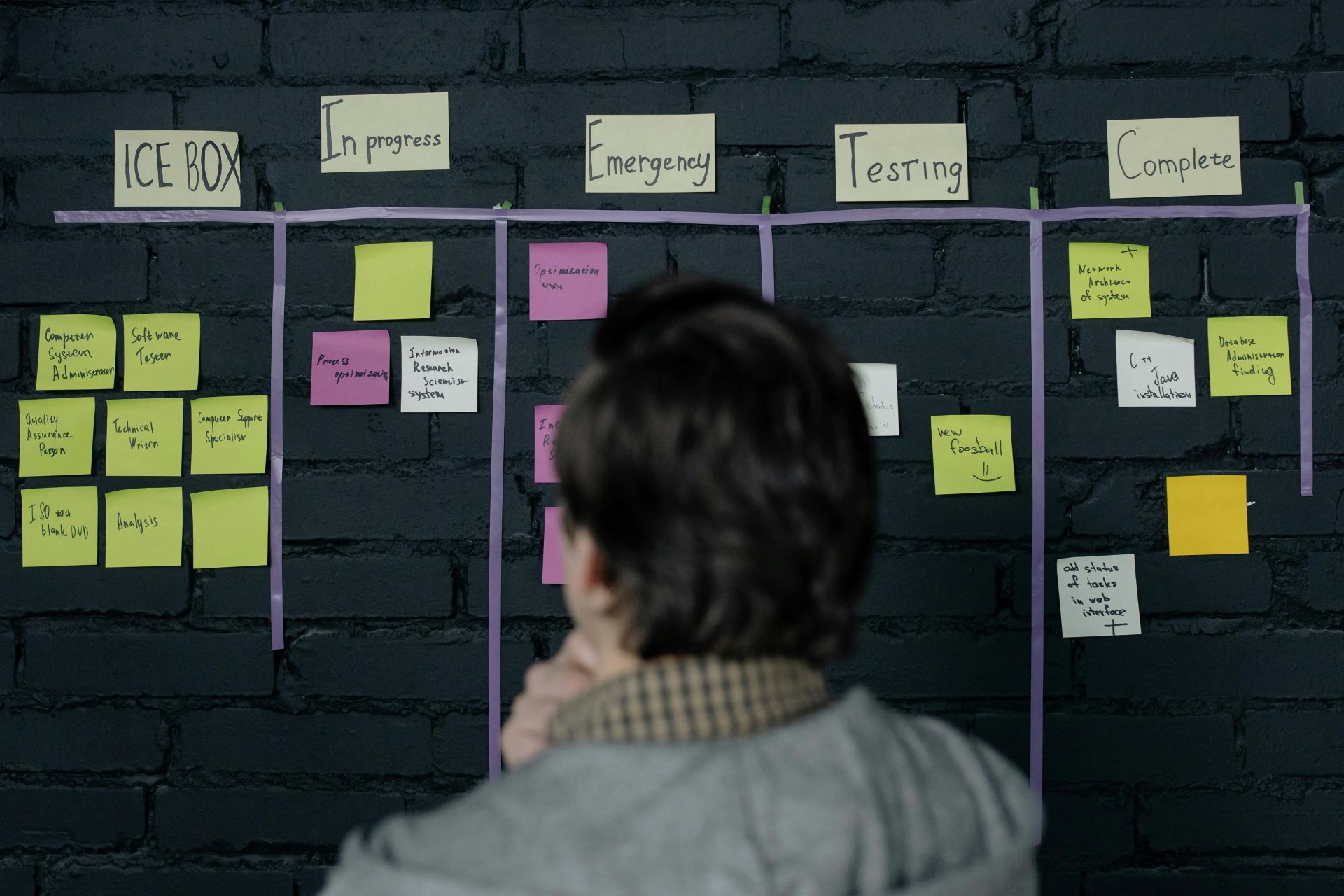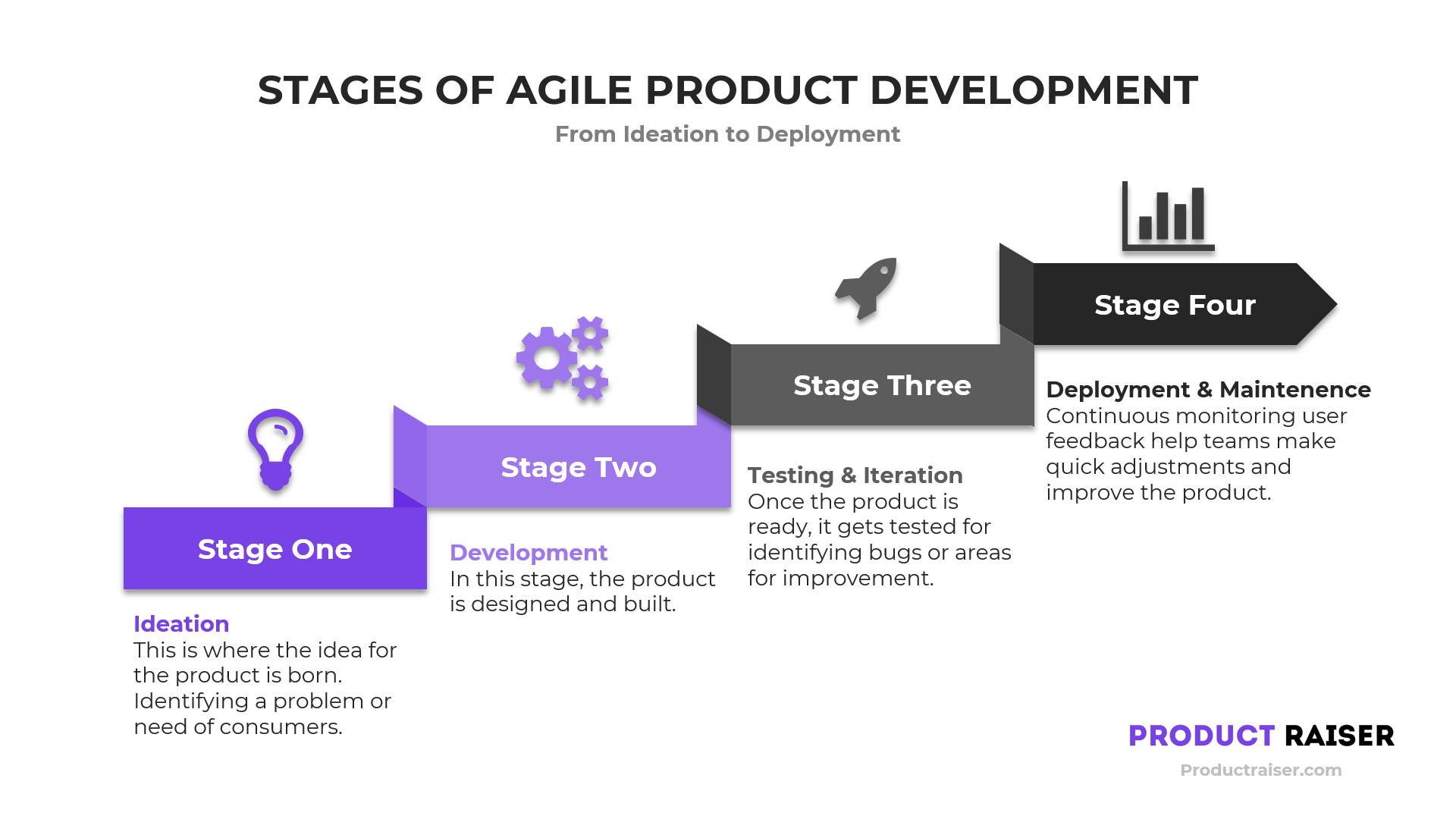Home
Agile Product Lifecycle Management: Key Principles, Roles & More (2024 Guide)
Unlock the secrets to becoming a successful Product Manager—from essential skills to career growth paths and insider tips for breaking into the field!
CHRISTIAN CASSISI – 11/09/2024

Product Manager working on his agile product lifecycle management kanban board / Pexels.com / cottonbro studio
1. Introduction to Agile Product Lifecycle Management
Understanding Agile in Product Lifecycle
In today’s fast-paced world, Agile Product Lifecycle Management (PLM) offers a dynamic way to manage the journey of a product. This approach applies Agile principles to all phases of a product’s life, from idea to launch and beyond. Unlike traditional models, Agile PLM focuses on flexibility, continuous feedback, and iterative improvements, enabling teams to respond swiftly to change.
Agile vs. Traditional Product Lifecycle Management
Traditional product lifecycle management (PLM) typically follows a linear, step-by-step model, often called “Waterfall.” Each phase—from planning to launch—is completed in sequence, making it well-suited for projects with stable, fixed requirements. However, once a stage is complete, revisiting it is challenging, making adjustments costly and time-consuming.
Agile Product Lifecycle Management (Agile PLM), by contrast, is built for flexibility. Instead of a strict sequence, Agile PLM uses short development cycles, or sprints, where teams build and test parts of the product continuously. This approach allows for quick adjustments based on ongoing feedback, helping the product stay aligned with customer needs and market trends. Agile PLM’s adaptability makes it ideal for fast-changing industries, where continuous improvement ensures that products remain relevant and competitive.
2. The Agile Flow: Stages of Agile Product Development

Ideation and Planning
The Agile process begins with ideation, where teams brainstorm product ideas based on market research and customer feedback. Planning follows, defining the product vision, scope, and success metrics in a flexible roadmap. Helpful in this phase are user or customer personas.
Design and Development
In Agile PLM, design and development are iterative processes. Teams work collaboratively, building and testing features in cycles to ensure functionality and usability. This approach fosters creative problem-solving and innovation.
Testing and Iteration
Testing is continuous in Agile product management. Each sprint concludes with testing, identifying bugs or areas for improvement. This iterative testing ensures a high-quality product by launch.
Deployment and Maintenance
Once deployed, an Agile-managed product is regularly updated and maintained. Continuous monitoring and user feedback help teams make quick adjustments, enhancing the product’s performance and user experience over time.
3. Popular Agile Methodologies in Product Management
Scrum
Scrum is one of the most widely adopted Agile methodologies in product management, known for its structured approach to managing complex projects. Scrum operates within fixed time-boxed iterations called sprints, typically lasting two to four weeks. Each sprint is a focused period where the team works towards completing specific tasks and delivering incremental product improvements. Daily stand-ups, or short team meetings, ensure everyone stays aligned on progress, addresses blockers, and recalibrates goals as needed.
Advantages: Scrum fosters high team accountability, visibility, and regular progress. With its structured sprints and set roles, including the Product Owner and Scrum Master, Scrum ensures continuous delivery and promotes a strong team dynamic. It’s especially advantageous for projects requiring rapid iterations, frequent releases, and consistent customer feedback integration.
Preferred Use Cases: Scrum is ideal for projects with evolving requirements and where product teams need regular check-ins and stakeholder involvement. It’s widely used in software development and digital product management but also adapts well to industries needing structured, iterative approaches to complex projects.
Kanban
Kanban is a highly visual Agile method focusing on managing workflows with a steady, continuous delivery. The core of Kanban is a visual board that displays tasks as they move through different stages, such as “To Do,” “In Progress,” and “Done.” By setting work-in-progress (WIP) limits, Kanban helps teams maintain a manageable workload, allowing members to focus on completing tasks before starting new ones. This structure reduces bottlenecks and helps maintain a consistent flow of work.
Advantages: Kanban’s main strength lies in its flexibility and adaptability. It’s effective for teams that need a clear view of their work but don’t require rigid time constraints. Kanban reduces idle time and supports continuous improvement by highlighting inefficiencies and promoting smoother workflows.
Preferred Use Cases: Kanban is ideal for projects requiring regular, small updates rather than major periodic releases. It’s popular in support teams, operations, and maintenance-focused roles, where consistent task management and efficiency are priorities.
Lean Product Management
Lean product management is rooted in the principles of Lean manufacturing, focusing on maximizing customer value by eliminating waste and optimizing resources. In this methodology, teams identify only the features and processes necessary to deliver value, ensuring that no effort or resources are spent on unneeded tasks. Lean product management encourages the “build-measure-learn” cycle, allowing teams to validate ideas quickly and make improvements based on real data.
Advantages: Lean product management minimizes waste, which leads to cost savings and greater resource efficiency. Its focus on continuous learning and fast iteration allows teams to pivot quickly based on user feedback, ensuring that product features meet actual customer needs.
Preferred Use Cases: Lean is particularly useful for startups and companies developing innovative or experimental products. It’s best suited for environments where product-market fit is uncertain, as it enables fast testing, iteration, and learning from real-world user feedback.
SAFe (Scaled Agile Framework)
The Scaled Agile Framework (SAFe) is an Agile methodology designed for large organizations that need to implement Agile practices across multiple teams. SAFe combines elements of Scrum, Kanban, and Lean to provide a structured framework for scaling Agile to complex projects. It operates on several levels (Team, Program, Large Solution, and Portfolio) to ensure alignment and coordination across the entire organization. With SAFe, teams can deliver in smaller iterations while maintaining a big-picture view of long-term goals.
Advantages: SAFe provides a structured yet flexible framework for scaling Agile across an enterprise, balancing Agile’s adaptability with the alignment needed for large teams. It improves coordination between teams, aligns work with strategic goals, and enables faster delivery across interconnected teams and departments.
Preferred Use Cases: SAFe is ideal for large enterprises with multiple product teams working on shared objectives or projects with interdependent deliverables. It’s often used in organizations that need to scale Agile principles to a broader organizational level while ensuring consistent practices across teams.
These Agile methodologies each bring unique strengths, allowing teams to choose the one that aligns best with their project requirements and team dynamics. Whether it’s the structured approach of Scrum, the flow-focused Kanban, the efficiency-driven Lean, or the scalable SAFe, each methodology helps product teams manage their lifecycle in a more adaptable, customer-focused way. The following video explains excellent in a nuthsell the basics of the “Agile Methodology”.
4. Key Roles in Agile Product Management
Product Owner
The product owner is the project’s visionary, responsible for defining the product roadmap and prioritizing features. They act as the bridge between stakeholders and the development team.
Scrum Master
The Scrum master facilitates the Agile process, ensuring that the team follows Agile practices and removing any obstacles. They promote a collaborative environment where the team can thrive.
Development Team
The development team executes the work in Agile PLM. They are self-organizing and cross-functional, with members taking on various roles to drive progress.
Cross-functional Roles in Agile
In Agile, collaboration extends beyond development. Marketers, designers, and other professionals work closely with the team to bring a comprehensive perspective to the product.
5. Benefits and Challenges of Agile Lifecycle Management
Advantages of Agile for Product Teams
Agile PLM offers numerous benefits, including faster product delivery, improved product quality, and increased flexibility. By delivering products in increments, teams can identify and fix issues early, leading to higher-quality results.
Common Challenges and How to Overcome Them
Despite its benefits, Agile PLM also has challenges. Keeping up with continuous feedback can be demanding, and rapid changes can create instability if not managed carefully. Clear communication, proper resource allocation, tracking “Product Management KPIs” and a committed team can help mitigate these challenges.
6. Agile Product Management vs. Waterfall
Key Differences
Agile and Waterfall represent two distinct approaches to product lifecycle management. While Waterfall is sequential, Agile is iterative and collaborative, allowing for greater flexibility and customer alignment.
| Aspect | Agile Product Management | Waterfall Product Management |
|---|---|---|
| Process Structure | Iterative and flexible; develops in cycles or sprints | Linear and sequential; follows a set, step-by-step process |
| Adaptability | High; allows frequent changes based on feedback | Low; changes are difficult and costly once a phase is complete |
| Customer Involvement | High; regular feedback is integrated throughout the process | Limited; feedback is usually gathered after completion |
| Project Scope | Evolving; scope can adapt over time based on insights and needs | Fixed; scope is defined at the beginning and rarely changes |
| Testing | Continuous; testing happens within each sprint | At the end; testing is usually conducted after development |
| Documentation | Lightweight; focused on essential information | Comprehensive; detailed documentation at each phase |
| Team Collaboration | Collaborative; team members work closely throughout each sprint | Limited; team collaboration often happens at defined stages |
| Ideal for | Projects with evolving requirements and a need for flexibility | Projects with stable requirements and clear end goals |
7. Future of Agile in Product Lifecycle Management
Agile product lifecycle management is evolving rapidly, with new trends emerging to enhance efficiency and decision-making. The integration of AI tools is a key development, helping Agile teams automate routine tasks, streamline workflows, and improve overall process efficiency. AI’s ability to analyze large datasets allows for quicker, data-driven decisions, enabling teams to focus on innovation. Predictive analytics further enhances decision-making by anticipating customer needs, ensuring product strategies are proactive and aligned with market trends. Additionally, data analytics is becoming increasingly important, empowering teams to gather real-time insights from customer feedback and make informed decisions on feature prioritization.
As industries grow more complex, Agile practices will continue to adapt to keep teams competitive and responsive. Agile’s customer-centric, iterative approach is crucial for navigating these changes, and its flexibility ensures that teams can quickly adjust their strategies based on real-time feedback. The continuous improvement focus of Agile, combined with emerging technologies like AI and data analytics, equips teams to stay ahead in a dynamic business environment.
Do you want to stay ahead in Product Management? Then subscribe to our newsletter to get exklusive insights, free content & more! Sign up Now!
Newsletter
MORE TIPS, TEMPLATES AND EXCLUSIVE INSIGHTS
Stay Ahead Of Others With Our Newest Articles
Launch your Amazon Product Successfully in 10 Steps
Learn how to optimize listings, gain reviews, and boost sales on Amazon in 2024.
Product Manager Explained
Master essential Product Management KPIs to boost growth, user satisfaction, and team efficiency with data-driven insights and strategies.
Master working with Product Management KPIs
Master essential Product Management KPIs to boost growth, user satisfaction, and team efficiency with data-driven insights and strategies.
How to Use Personas
Learn how to turn your customer personas into actionable insights that improve your product development and marketing strategies.
Create and Design the Perfect Customer Persona
Learn how to create data-driven user personas that turn guesswork into smart product decisions to drive your product’s success.
Everything You Need to Know About Product Management for Beginners
Unlock the secrets of successful product management and learn how to turn ideas into winning products.






